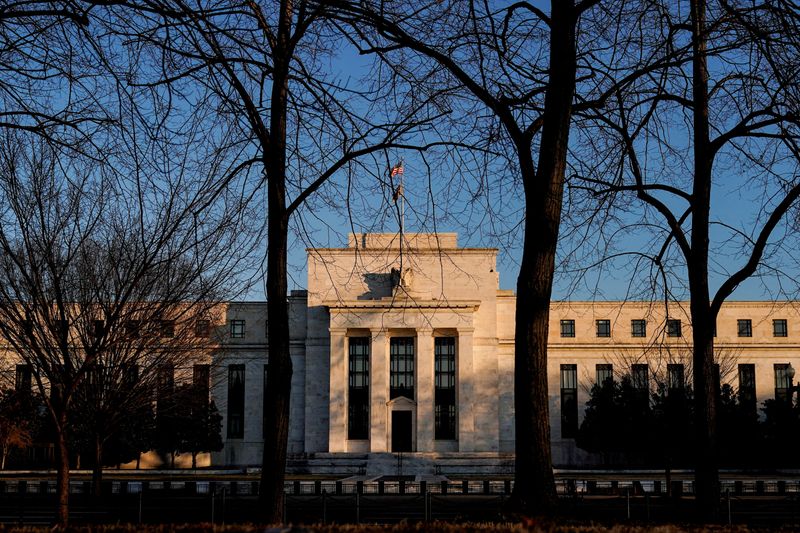© Reuters. FILE PHOTO: The Federal Reserve building is seen in Washington, U.S., January 26, 2022. REUTERS/Joshua Roberts/File Photo
By Yoruk Bahceli
(Reuters) – Borrowers looking for relief from higher interest rates may be set for disappointment with financial markets indicating rates will stay elevated for years to come.
However much they fall in 2024, pricing in money markets highlights a view that the decade of near-zero interest rates prevailing after the great financial crisis is unlikely to return while inflationary pressures and government spending stay high.
That risks further pain for many public and private borrowers who locked in past lower rates and have yet to feel the full impact of the record-paced central bank hikes of the last two years.
Traders have in recent weeks doubled down on bets for steep rate cuts next year, encouraged by slowing inflation and a dovish shift from the U.S. Federal Reserve.
Expectations that rates will drop at least 1.5 percentage points in the United States and Europe have boosted bond and equity markets.
But while the Fed is expected to cut its key rate to around 3.75% by the end of 2024, it will only fall to around 3% by the end of 2026, then rise back to around 3.5% thereafter, money market pricing suggests.
That is in stark contrast to rates staying near zero for most of the decade following the global financial crisis, only gradually rising to 2.25%-2.50% in 2018.
European Central Bank rates are seen at roughly 2% by end-2026, from 4% currently – a reduction but hardly a sign of any return to the unorthodox experiment with negative rates seen from 2014 to 2022.
“It’s just normalizing policy. It’s not going into easy monetary policy,” Mike Riddell, senior portfolio manager at Allianz (ETR:) Global Investors, said.
Such expectations are consistent with a scenario where the so-called ‘neutral’ interest rate, which neither stimulates nor slows economic growth, has risen since before the COVID-19 pandemic, economists say.
The U.S. economy so far avoiding a recession many expected in the face of aggressive policy tightening has also supported that argument.
Higher inflation risks on the back of geopolitical tensions and reshoring, looser fiscal policy and potential improvements in productivity from the likes of AI are among factors that may be lifting the neutral rate, often dubbed ‘R-star’.
Some notion of the neutral rate, though impossible to determine in real time, is key to understanding an economy’s growth potential and a central bank’s decision on how much to reduce rates going forward.
Whether the neutral rate has moved is subject to much debate and not everyone is convinced it has risen.
Crucially, market expectations are higher than the Fed’s 2.5% estimate for long-term interest rates, though several policymakers have put it above 3%.
In the euro area, ECB policymakers point to a neutral rate of around 1.5%-2%.
“I’m sceptical that there’s been much of a change in R- star,” former Fed economist Idanna Appio, now portfolio manager at First Eagle Investment Management, said.
Appio is puzzled why markets are pricing in continued high rates while many measures of inflation expectations suggest it should return to central banks’ targets. It’s too early to call a rise in productivity, she added.
Gauging where rates will head in the coming years is far from easy and markets can get things wrong.
But their expectations warrant caution for borrowers, who are accustomed to and still benefiting from the low rates of recent years.
“It means that corporates will need to refinance at reasonably to sometimes significantly higher rates than what they had in the books over the last five years,” Patrick Saner, head of macro strategy at Swiss Re (OTC:), said.
“In this context, the higher rates environment actually matters quite a lot, particularly when it comes to corporate planning.”




